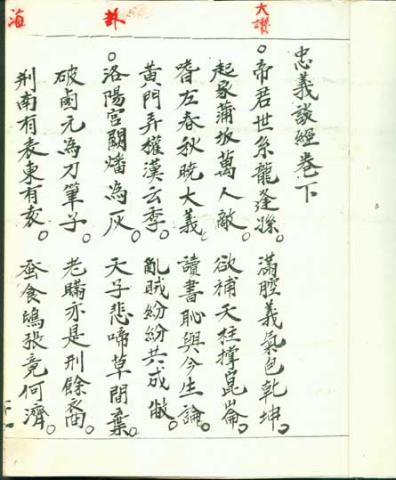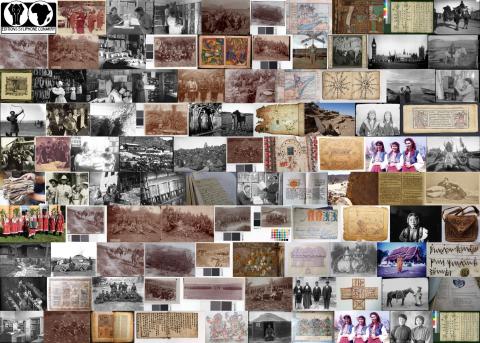Aims and objectives
The Shui manuscripts in south Guizhou are crucial but endangered materials for studies on the indigenous Shui ethnic group and its unique culture in Southwest China. Following the establishment of a major surrogate archive of Shui manuscripts in earlier project EAP143, this project aims to complement it by selected newly-found volumes from private collections in Libo, Dushan, Duyun, Rongjiang and Liping. Comparing with those in public collections, the materials covered by this project are threatened more seriously by carelessness and smuggling, therefore demand immediate preservation. This project will enrich the digital collection of Shui manuscripts by about 200 volumes.
Shui manuscripts (spelled as lesui in the Shui language) are ritual texts for the Shui people, a native ethnic group in the South Guizhou. They are written in a hieratic graph circulating among the Shui masters, indigenous priests correlating to Shamans in many tribe societies. Although the native claim that the Shui graph is the last surviving hieroglyphics still demands reliable evidence, the earliest Shui manuscripts can be safely dated to the 16th century. It is a traditional way for Shui people to ask for supernatural consent through Shui masters before making important decisions or on crucial occasions in their lives, such as births, funerals, erecting pillars of new houses and long travels. Such a tradition is still present today. The contents of the Shui manuscripts cover knowledge on astronomy, geography, folklore, religion, ethics, philosophy, art and history. Therefore, Shui manuscripts are not only the key and irreplaceable materials to understand the unique culture of the Shui people, but also constructive for studying history, anthropology, folklore and even palaeography in general.
Presently, Shui manuscripts are mainly found in Sandu, Libo, Dushan, Duyun, Liping, Congjiang and Rongjiang in Guizhou and Hechi in Guangxi. The public archives in several counties have accumulated up to 14,000 volumes, and the sum of manuscripts in various private collections is 2,500 volumes. This project aims to preserve about 200 volumes of Shui manuscripts, currently kept by private collectors in south Guizhou and never previously accessed by researchers.
The manuscripts are written on local-made cotton paper, which is apt to perish in poor conditions of space, temperature and humidity. The manuscripts are also endangered by neglect, lack of financial support, political discrimination and recent social change. Although some scholars have tried for years to establish an archive or museum to preserve the Shui cultural heritages, very limited advance has been achieved. Raising the profile of Shui manuscripts locally had a fatal side-effect of encouraging smuggling and illegal trading, with many manuscripts disappearing.
This project will supplement the database of Shui manuscripts created by project EAP143 project. About 200 volumes will be digitised from counties other than Libo and Sandu by means of scanning or photographing.
Outcomes
216 Shui manuscripts held in private collections in South Guizhou have been digitised and digital copies deposited with Sun Yat-sen University and with the British Library.
The records copied by this project have been catalogued as:
- EAP460/1 Shui Priest manuscripts, Duyun, Guizhou [19th century-20th century]
- EAP460/2 Shui priest manuscript, Rongjiang, Guizhou [Early 20th century]
- EAP460/3 Shui Family Volume, Duyun, Guizhou [1968]
- EAP460/4 He Chaorong Collection [Late 20th century]
- EAP460/5 Meng Xuefang Collection
- EAP460/6 Pan Guotai Collection
- EAP460/7 Pan Zaibiao Collection
- EAP460/8 Pan Decai Collection
- EAP460/9 Pan Guohui Collection
- EAP460/10 Pan Liangmin Collection
- EAP460/11 Pan Wenjun Collection
- EAP460/12 Pan Jiayi Collection
- EAP460/13 Shi Wenfeng Collection
- EAP460/14 Wei Tianhui Collection
- EAP460/15 Wei Guizhou Collection
- EAP460/16 Wei Kehuai Collection
- EAP460/17 Wei Tianyi Collection
- EAP460/18 Manuscript from Leishan, Guizhou
- EAP460/19 Pan Xueyi Collection
- EAP460/20 Yao Changzhao Collection
- EAP460/21 Yao Shengbo Collection
- EAP460/22 Pan Yongchang Collection
- EAP460/23 Yang Guangshun Collection
- EAP460/24 Yao Shengfen Collection
- EAP460/25 Pan Yuguang family
- EAP460/26 Yang Guanghan Collection
- EAP460/27 Yang Guanglu Collection
- EAP460/28 Yang Guangming Collection
- EAP460/29 Yao Changneng Family Collection
- EAP460/30 Unnamed Private Collection 1
- EAP460/31 Unnamed Private Collection 2
- EAP460/32 Yang Guangshun Collection
- EAP460/33 Yang Shengting Collection
- EAP460/34 Wu Guangyu and Yao Ziming Collection
- EAP460/35 Fu gui gen ji Manuscript Collection
- EAP460/36 Yao Changxi Family Collection
- EAP460/37 Ji shi jin ji zhishi Manuscript Collection
- EAP460/38 Yao Changzhou Collection





